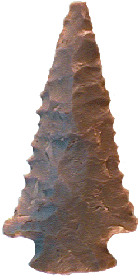

Point Type: DECATUR
Also See: Abbott, Amos Corner-Notched,
Angelico Corner-Notched, Autauga, Barbee Corner Notched,
Broadhead Side-Notched, Church Hill, Cobbs Triangular, St. Charles a.k.a. Dovetail , Hardin, Kirk Corner Notched , Lost Lake, Neuberger
Location: Southeastern and Midwest United States
Associated Dates:
9500 - 7000 B.P. - Early Archaic
Morphology: Corner
Notched
General Description: The Decatur type is a small to medium sized, serrated, corner notched, trianguloid bladed projectile point that terminates with barbs at the shoulders and is usually alternate beveled on one side of each face. The blade edges are typically convex on pristine examples and become straight to concave with reworking. The unique basal treatment of the Decatur is the most characteristic trait for this point type. The base was first indented at the center. The basal corners were prepared as a platform from which to detach a burin spall from each corner. The basal corner was then broken off (fractured) by a blow inward from each corner of the stem. This basal edge flattening was accomplished by the use of the burin flaking technique. Sometimes the sides of the stem and backs of the tangs are also fractured off. On rare specimens, the tip may be fractured by a blow on each side directed towards the base. Bases are usually ground and flaking is of high quality. In general, the base is small and expanding. On certain specimens, the basal grinding can nearly obliterate the burin facets. The type is called a "Fractured Base Point" in Ohio. The unfractured form of this type is called Angelico Corner-Notched in Virginia. It is possible that the Cobbs Triangular was a preform for the Decatur point.
Decatur points are found primarily in the Southeast and Midwest regions of the United States especially the Tennessee Valley in northern Alabama and Tennessee. The type is relatively rare and is not found in great numbers anywhere. It is found in very low frequency in Kentucky, across most of Indiana, Ohio, southern Michigan and southern to middle Illinois and very rarely in Pennsylvania.
The size of the Decatur point can range from 29 mm to 102 mm in length with the typical point being in the 52 mm range. The average width of the blade is 28 mm with the range being from 22 mm to 38 mm. The average stem width is 19 mm with the range being from 13 mm to 25 mm. The average thickness is 6 mm with the range being from 5 mm to 7 mm. The Decatur point type was named by James W. Cambron for specimens he found at sites near Decatur, Alabama.
About The Point Above: The large Decatur point pictured at the top of this page, was found in Humphreys County, Tennessee. It is made from a glossy gray flint material. The point is alternatly beveled on each face and the basal edges are struck and slightly ground as well as are the corner notches. The tip is also struck on both faces resulting is a razor sharp tip edge. The tangs are not struck. The point has parallel flaking scars on each blade face and the edges of each blade are serrated (especially near the basal end). Overall, the point measures 63 mm in length, is 38 mm wide at the barbs and is 7 mm thick at mid blade near the shoulders. The base measures 19 mm in width. Catalog Number 22-35-D
References: Baker, Converse, Dragoo (e), Fogleman, Justice, Overstreet, Waldorf
© Copyright 1997 - 2008 LITHICS-Net WWW.LITHICSNET.COM
Use your Browser's BACK Button to return to the LITHICS-Net Index.